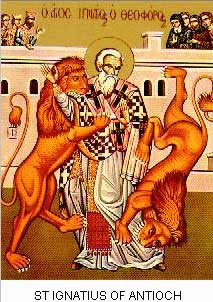
William R. Schoedel comments on the recensions of Ignatius (The Anchor Bible Dictionary, v. 3, p. 384-385):
Eusebius (Hist. Eccl. 3.36) places Ignatius' martyrdom in the reign of Trajan (A.D. 98-117), and a date in the second half of Trajan's reign or somewhat later seems to fit the picture of the conditions reflected in the letters. Arguments are still advanced (notably by Joly 1979) that call into question the authenticity of these documents, but the researches of Zahn (1873) and Lightfoot (1885, 1889) and their followers continue to dominate the scholarship. Thus the authenticity of (a) what is not often, though misleadingly, called the "middle recension" is generally accepted. By the same token, (b) the so-called "long recension" is usually regarded as a 4th-century (perhaps Neo-Arrian) revision (Hagerdorn 1973: xxxvii-lii) consisting of interpolations into the original letters and the addition of 6 spurious letters. This recension is found in numerous Greek and Latin manuscripts and came to be the form in which Ignatius was most often known until Archbishop Ussher, in his Polycarpi et Ignatii Epistolae of 1644, brilliantly unearthed an earlier (Latin) form of the text akin to that quoted by Eusebius. Ussher had rediscovered the middle recension. The Greek of that recension (except for the letter to the Romans) became available with the publication of Igantius' letters from Codex Mediceo-Laurentianus 57,7 by Isaak Voss in 1646. The Greek text of Ignatius' letter to the Romans had a separate history as part of an account of Ignatius' martyrdom (Codex Parisiensis-Colbertinus 1451), and this too was soon published by Th. Ruinart (1689). Our knowledge of the middle recension has been increased somewhat by the discovery of several important oriental versions: Coptic (fragments), Syriac (fragments), Armenian, Arabic. It should be noted that almost all of the collections of letters of the middle recension in the manuscripts also include some or all of the spurious letters. Since the interplations and the spurious letters are in all likelihood the work of one person, these collections represent a curious mixture of textual traditions. Finally, (c) what some have called the "short recension" proves to be no recension at all but merely an abridgment of a Syriac version of the middle recension. The term short recension, then, would serve most accurately to describe the so-called middle recension and is often so used.
Go to the Chronological List of all Early Christian Writings
Please buy the CD to support the site, view it without ads, and get bonus stuff!
Early Christian Writings is copyright ©
Peter Kirby <E-Mail>.
Kirby, Peter. "St. Ignatius of Antioch." Early Christian Writings. <http://www.earlychristianwritings.com/ignatius.html>.